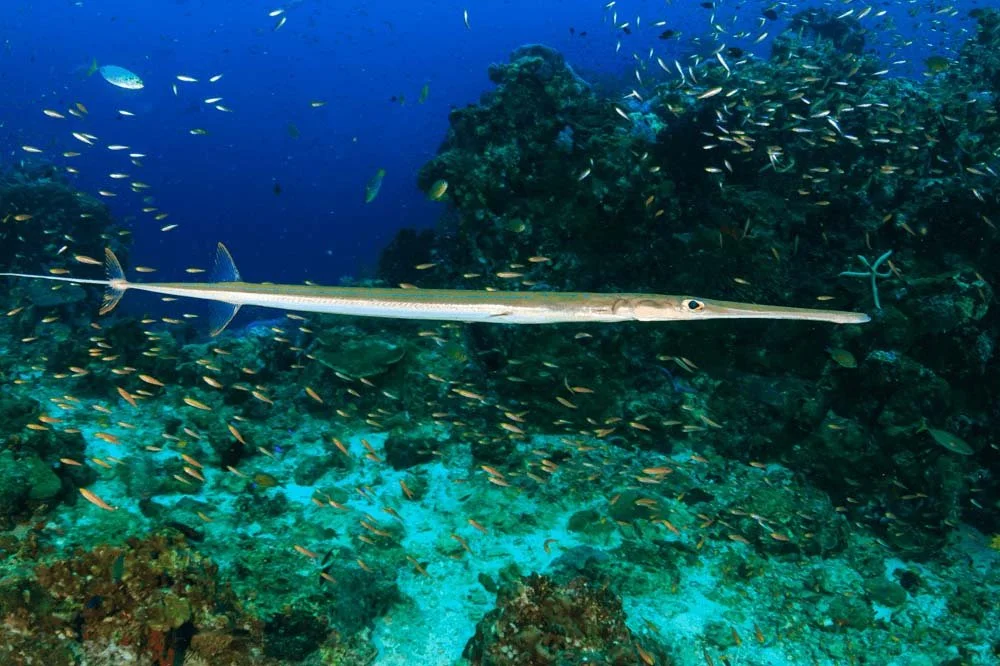
Meet our #IconicFishes
Seahorses lead a glorious orchestra of musical marine life: pipefish, ghost pipefish, trumpetfish, cornetfish, and bellowsfish, with the seadragon as the closing act, the elegant dancer and showstopper. Along with evoking harmony and intrigue through their names, these quirky fishes tell wondrous stories of camouflage and male pregnancy, mate fidelity and ambush predation, stealthy swimming and meditative stillness.
These are the unsung heroes of our seas.
Help us amplify their stories with your creativity.
Seahorse
About 46 known species of seahorses, from little to large, live along the world’s tropical and temperate coastlines
Fun fact
Seahorses are known as the superdads of the sea! Male seahorses become pregnant. The female deposits eggs into the male's brood pouch, where he fertilizes them. He then provides oxygen, nutrition and a controlled environment for 10 days to six weeks. Males go into labour to give birth to between five and two thousand young, depending on the species.
Dive into our inspiration kit, to learn more about the magical seahorse!
Photo credit: © Filip Staes / Guylian Seahorses of the Word
Pipefish
There are about 225 species of pipefishes, which belong to the same family (Syngnathidae) as seahorses and seadragons. The name “pipefish” comes from their long, slender bodies, which resembled the smoking pipes used in the mid-1700s. To us, they also evoke the shapes of musical instruments with pipes, from bagpipes to clarinets, organs, and tubas.
Fun Fact
Some pipefish can glow under blue or ultraviolet light, a cool ability called biofluorescence. This might help them communicate or stay hidden.
Dive into our inspiration kit, to learn more about the pipefish!
Photo credit: © Richard Smith / Ocean Realm Images
Ghost pipefish
There are six species of ghost pipefishes, all in one family (Solenostomidae) and one genus (Solenostomus). They are found in the tropical waters of the Indo-Pacific. Both their scientific name (Solenostomus) and their common names (Ghost pipefish) holds its musical reference in “pipe”.
Fun Fact
Ghost pipefish have long courtship rituals that can last up to three days before they decide to mate. Males will try to impress females by swimming in circles around them and quickly opening and closing their dorsal fins to show off bright colours.
Dive into our inspiration kit, to learn more about the ghost pipefish!
Photo credit: © Wirestock Creators / Shutterstock
Trumpetfish
There are three species of trumpetfishes, found across tropical waters around the world. Their common name, trumpetfish, comes from their long, tubular shape, which resembles a trumpet. Their scientific name, Aulostomus, also carries a musical reference: “aulos,” often translated as “flute,” though it was actually a reed instrument from ancient Greece.
Fun Fact
Being large and conspicuous, trumpetfish use camouflage to sneak up on prey. They can change colour rapidly due to cells called chromatophores. They can switch to darker or lighter colouring, and vary the intensity of spots or stripes.
Dive into our inspiration kit, to learn more about the trumpetfish!
Photo credit: © Richard Whitcombe/ Shutterstock
Cornetfish
There are four species of cornetfishes/flutemouths, found in most parts of the tropics. Their scientific name (Fistularia) and one of their common names (Flutemouth) both hold a musical reference in “flute”, and another common name (Cornetfish) holds its music reference in ”cornet”. Musical cornets are usually shorter than trumpets, but cornetfish are notably longer than trumpetfish.
Fun Fact
Cornetfish use "hunting associations" with octopuses. They follow octopuses, waiting for small prey to be scared out of hiding as the octopus explores crevices in the rocks.
Dive into our inspiration kit, to learn more about the cornetfish!
Photo credit: © Richard Whitcombe / Shutterstock
Bellowsfish
There are six species of bellowsfishes, members of the family Centriscidae, which also includes snipefishes, shrimpfishes, and razorfishes.
The name bellowsfish comes from their distinctive shape, reminiscent of bellows, a device that delivers a strong blast of air. Bellows have long been used to power musical instruments such as accordions, concertinas, bagpipes, pipe organs, and reed organs.
Fun Fact
These fish do not change colour for camouflage, but they do change colour during mating rituals.
Dive into our inspiration kit, to learn more about the bellowsfish!
Photo credit: © Giunchi on iNaturalist.org
Seadragon
There are three species of seadragons, all belonging to the same family (Syngnathidae) as seahorses and pipefishes: the weedy seadragon, the leafy seadragon, and the recently discovered ruby seadragon. They are found exclusively off the southern coast of Australia.
Fun Fact
Seadragons have a long tube snout and leaf-like appendages that extend from their various nobs and ridges, resembling the flowing costumes of dancers. These delicate "leaves" not only give them a graceful, decorative appearance but also help them blend seamlessly into the seaweeds they call home. Just like other fishes in the family, they also have the ability to change colours.
Dive into our inspiration kit, to learn more about the seadragon!
Photo credit: © Dmitry Rukhlenko / Shutterstock
Banner image of cornetfish © Richard Whitcombe / Shutterstock






